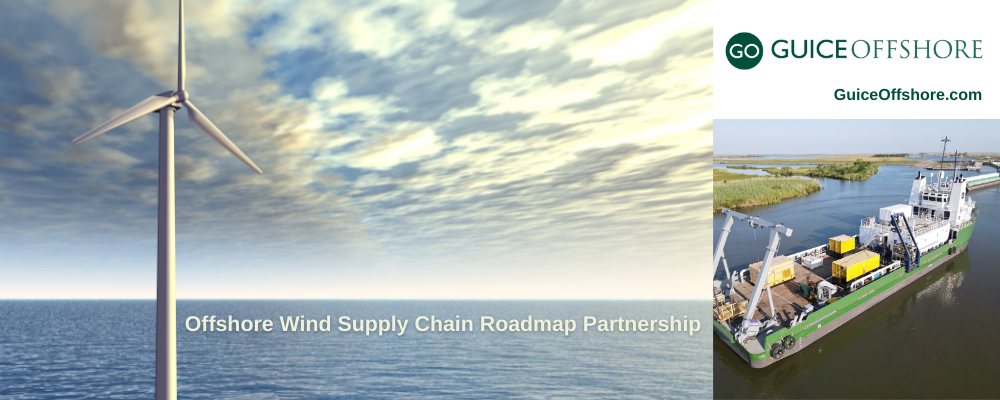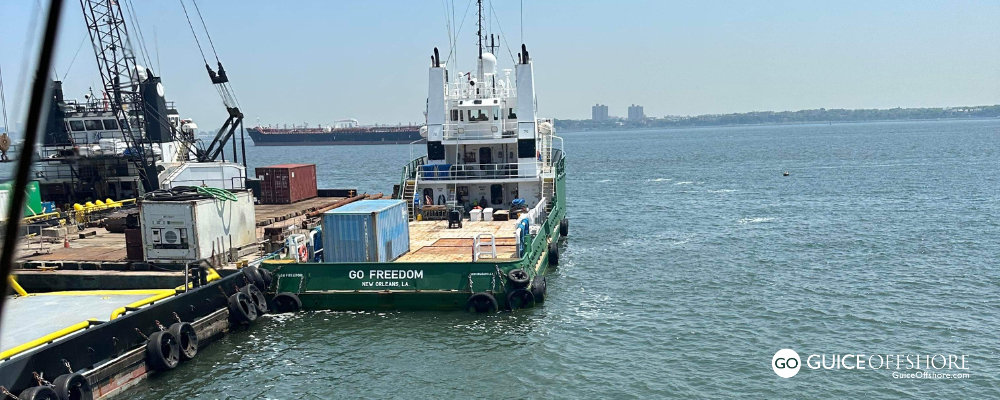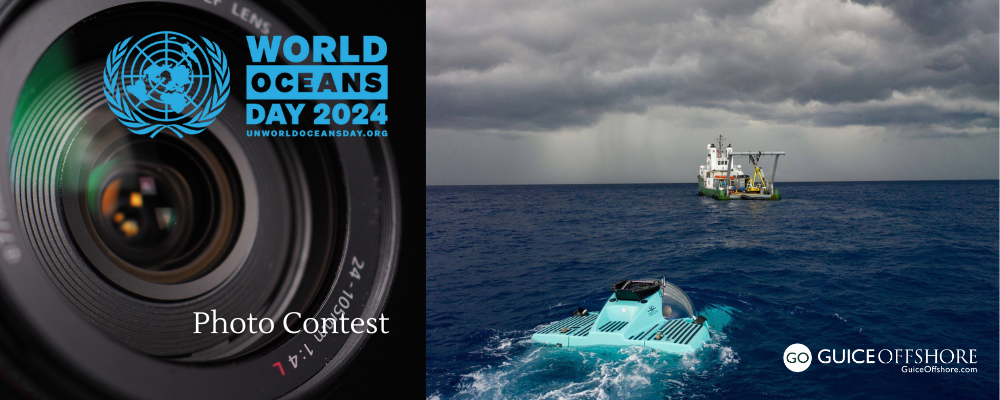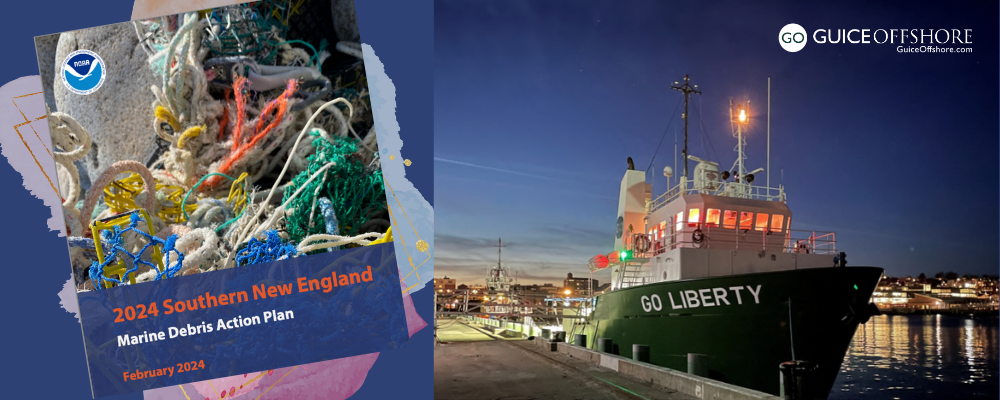New Offshore Wind Supply Chain Roadmap Partnership Will Advance Rapid U.S. Offshore Wind Deployment, Create Good-Paying Jobs to Equitably Benefit Local Communities, and Increase Energy Security
Following the National Renewable Energy Laboratory (NREL) March 2022 report entitled The Demand for a Domestic Offshore Wind Energy Supply Chain, the U.S. Department of Energy (DOE) announced during late June 20222 that it will lead in the development of a comprehensive offshore wind supply chain roadmap as part of its participation in the new White House-led Federal-State Offshore Wind Implementation Partnership.
Guice Offshore, widely considered to be the U.S Flag leader in the operation of dynamically positioned mini-supply vessels and compact, cost-effective multi-purpose vessels for specialty markets such as offshore wind energy, is playing a pivotal role in providing one of the primary needs in the offshore wind supply chain–offshore supply vessels for a multitude of needs, including crew transfer, equipment transport and subsea surveying.
This first of its kind forum between 11 East Coast Governors and Administration officials will enable collaboration to build a strong, U.S.-based supply chain for offshore wind, grow a skilled U.S. workforce, and accelerate work to address important regional matters. The partnership will advance the industry’s rapid development and provide more affordable clean energy to all Americans, helping accelerate the federal government’s goal of 30GW of offshore wind capacity by 2030 and 100% clean electricity by 2035.
“Working together – states and the federal government – we can blow the lid off our growing domestic offshore wind industry and get us to our clean energy future faster,” said U.S. Secretary of Energy Jennifer M. Granholm. “The new Federal-State Offshore Wind Implementation Partnership will help build a strong domestic supply chain for offshore wind and a foundation for delivering an abundance of clean energy, along with more good-paying jobs.”
State and federal collaboration will help achieve the U.S. goal of 30 GW of offshore wind capacity by 2030. Achieving this goal will result in an expected $12 billion in annual investment in offshore wind projects, which in turn can lead to the construction of up to 10 manufacturing plants for offshore wind turbine components and new ships to install the turbines. The nation’s offshore wind goal will also support nearly 80,000 jobs in the industry and surrounding local communities, power more than 10 million homes, and cut 78 million metric tons of carbon dioxide emissions.
The Federal-State Offshore Wind Implementation Partnership highlights ongoing DOE efforts and commitment work alongside states and industry to provide a roadmap that identifies key pathways for meeting state and federal offshore wind goals. The federal and state partners will work together to further grow U.S. offshore wind energy, anticipate needs, and solidify and expand key offshore wind supply chain elements, such as domestic manufacturing, logistics, transmission, and workforce development.
The partners also will engage with underserved communities, ocean users, Tribes, local governments, and other stakeholders to ensure that supply chain development provides equitable benefits and minimizes any potential adverse impacts. Already, the DOE and the Department of Commerce are partnering to research the impacts of offshore wind and other types of ocean-based energy on coastal communities and the fishing industry, and learn how to align deployment with community values.
NREL is leading the 30 GW by 2030: A Supply Chain Road Map for Offshore Wind in the United States project to create a road map that identifies challenges and solutions to developing a nationally focused offshore wind energy supply chain that has the potential to manufacture all major components domestically by 2030.
The project is overseen by the National Offshore Wind Research and Development Consortium and conducted by a partnership among NREL, the Business Network for Offshore Wind, and DNV. Funding and support are provided by the National Offshore Wind Research and Development Consortium, the Maryland Energy Administration, and the U.S Department of Energy.
The aforementioned first part of the road map, released in March, details the top-level demand for deployment, components, ports, vessels, and workforce required to achieve the U.S. goal of 30GW of offshore wind capacity by 2030. The report forecasts the need for an offshore wind workforce averaging between 12,300 and 49,000 full-time workers annually.
The second part of the road map, to be released by the end of 2022, will detail scenarios that would achieve U.S. manufacturing of major components by 2030, including manufacturing facilities, workforce requirements, and manufacturing capabilities; evaluate the potential benefits of such a supply chain; identify realistic pathways to achieve this supply chain; and determine the readiness of existing industries to support supply chain development.
The landmark investments from the Bipartisan Infrastructure Law include $2.5 billion to the DOE to expand and update the nation’s transmission network, including potential connections to offshore wind. The transformative law also invests $8 billion for hydrogen hubs, which could use offshore wind energy to produce hydrogen or hydrogen-derived fuels.
Developers of infrastructure for the offshore wind energy industry are encouraged to apply for funding through DOE’s Loan Programs Office.
Learn more about the Wind Energy Technologies Office in DOE’s Office of Energy Efficiency and Renewable Energy.
White House Convenes Offshore Wind Industry Leaders, Suppliers
White House Convened Governors, Labor Leaders, and Private Companies to Boost Offshore Wind Supply Chains, Lower Energy Costs, and Support Manufacturing Jobs
On June 23, 2022, the White House announced that, as a first step of the Offshore Wind Supply Chain Partnership, commitments have been made to collaborate on expanding key elements of the offshore wind supply chain, from manufacturing facilities to port capabilities to workforce development. The Biden Administration also announced steps to advance the National Offshore Wind Supply Chain Roadmap and designate offshore wind vessels as Vessels of National Interest to facilitate more offshore wind construction.
After years of Americans facing energy uncertainty, decisive action has now been taken to jumpstart the American offshore wind industry, with a bold goal of deploying 30 gigawatts (GW) of offshore wind by 2030, enough to power 10 million homes with clean energy, support 77,000 jobs, and spur $12 billion per year in private investment in offshore wind projects. Since then, the first large-scale projects have been approved that established new wind energy areas, followed by record-breaking wind auctions—signature achievements that advance American commitment to tackle the climate crisis and strengthen American energy security.
These bold actions have unleashed historic private sector investments to expand an American-made wind energy supply chain. In 2021 alone, investors announced $2.2 billion in new funding, including commitments to develop nine major manufacturing facilities to produce the foundations, towers, cables, and blades of offshore wind turbines. Supplier contracts to provide materials and services to offshore wind projects more than doubled. And historic project labor agreements are helping to grow a diverse union workforce and support training programs.
More opportunities are ahead, including an estimated $109 billion revenue opportunity across the offshore wind supply chain this decade, and East Coast Governors are laying the groundwork to seize them. Having already set commitments to procure nearly 40 GW of offshore wind, these states are providing a strong demand signal for clean energy that will lower energy costs for American families while protecting them from volatile fossil fuel price spikes. Collaboration between state and federal governments already is helping to create good-paying jobs and establish a durable domestic supply chain to facilitate the responsible development of America’s world-class offshore wind resource.
The collaboration includes labor and industry leaders, and the aforementioned governors who joined National Climate Advisor Gina McCarthy, Secretary of the Interior Deb Haaland, Secretary of Energy Jennifer Granholm, Deputy Secretary of Transportation Polly Trottenberg, and National Oceanic and Atmospheric Administration Administrator Rick Spinrad to:
- Launch the Federal-State Offshore Wind Implementation Partnership: Eleven leading states along the East Coast will participate in this new Partnership, a first-of-its-kind forum for collaboration between federal and state officials to accelerate offshore wind progress. The partners will work together to build a strong, U.S.-based supply chain for offshore wind, grow a skilled U.S. workforce, and build on work to address important regional matters such as transmission and interconnection, fishing and other ocean co-use issues, and other key priorities. The Federal-State Partnership will look to expand to the West Coast and the Gulf of Mexico as offshore wind energy projects develop in those regions.
- Leverage State and Federal Actions to Strengthen the U.S. Offshore Wind Supply Chain: As a first step of this new Partnership, the Biden Administration and Governors are endorsing a set of federal, state, and mutual commitments to expand key elements of the supply chain, including manufacturing facilities for offshore wind components, port capabilities, logistics networks needed to install projects, and workforce development to fill good-paying jobs. Working together, federal and state partners will track progress, anticipate future needs, and collaborate on a regional and national basis.
- Advance the National Offshore Wind Supply Chain Roadmap: The Department of Energy, along with New York and Maryland, is providing funding to develop a comprehensive offshore wind supply chain roadmap, through a collaboration led by the National Offshore Wind Research and Development Consortium and with partners including the Business Network for Offshore Wind. As part of this effort, in March 2022 the National Renewable Energy Laboratory released a report on supply chain needs, including manufactured components, ports, and vessels, to deploy 30 GW by 2030. Secretary Granholm announced a July workshop for stakeholders, including state officials, to provide input on a roadmap, for release later this year, laying out actions to meet these supply chain needs.
- Announce Priority Financing for Offshore Wind Vessels: Constructing offshore wind projects requires specialized installation vessels, and projections from the National Offshore Wind Supply Chain Roadmap show that U.S. and global vessel supply will need to increase to meet and accelerate offshore wind deployment. Today, the Department of Transportation’s Maritime Administration (MARAD) is announcing the designation of offshore wind vessels as Vessels of National Interest for support through the Federal Ship Financing Program, giving these applications priority for review and funding. The program assists the domestic shipbuilding industry, providing support for U.S. shipyards to modernize their facilities, to build and retrofit vessels, and to assist U.S shipowners to cost-effectively obtain domestically produced new vessels.
Accomplishments to date on offshore wind have included:
- Approval of the nation’s first two commercial-scale offshore wind projects, Vineyard Wind and South Fork Wind, both now under construction and being built by union labor. The Department of the Interior (DOI) initiated the review of an additional 10 projects that, if approved, represent 22 GW of clean new energy for the nation.
- Announcement of an ambitious leasing strategy for the DOI to hold up to seven offshore wind auctions by 2025—two of which were held earlier this year—including areas in Gulf of Maine, New York Bight, Central Atlantic, and Gulf of Mexico, as well as offshore the Carolinas, California and Oregon.
- Holding a record-breaking wind lease sale in the New York Bight, bringing in $4.37 billion in winning bids for areas with the potential to power nearly two million homes. DOI also joined with New York and New Jersey to launch a shared vision on offshore wind supply chain development, with a focus on delivering benefits to underserved communities. The Federal-State Offshore Wind Implementation Partnership will build on these efforts.
- Utilization of Lease Provisions to Leverage Union Jobs and Supply Chain Development to Accelerate Wind Development: The historic New York Bight lease sale included incentives to source major components like blades, turbines and foundations domestically and encouraged use of project labor agreements to ensure that these projects are built as quickly and safely as possible. Last month, DOI’s Carolina Long Bay lease sale included a new credit for bidders who committed to support workforce training programs or U.S. supply chain development, generating $42 million in funding.
Federal-State Offshore Wind Implementation Partnership
The new Federal-State Offshore Wind Implementation Partnership is a joint effort of the White House National Climate Advisor, the Secretaries of the Interior, Energy, Commerce, and Transportation, and the Governors of several East Coast states who are early leaders on offshore wind development: Connecticut, Delaware, Maine, Maryland, Massachusetts, New Hampshire, New Jersey, New York, North Carolina, Pennsylvania, and Rhode Island.
An initial focus area of the Partnership will be collaboratively growing a strong U.S. offshore wind supply chain. Going forward, the Partnership will provide a forum for new initiatives and in coordination with existing efforts to address ocean co-use, transmission needs and other offshore wind priorities that may benefit from additional federal, state, and regional coordination. The Partnership will expand to include Governors from the West Coast and the Gulf of Mexico as offshore wind energy projects develop in those regions.
New Commitments to Strengthen the U.S. Offshore Wind Supply Chain
During the June 23 White House event, Administration officials and Governors endorsed this set of commitments to solidify and expand the domestic manufacturing capacity, logistics networks, and workforce development needed for a U.S. offshore wind supply chain that creates good-paying jobs and equitably benefits local communities.
Mutual Federal-State Commitments
To ensure the development of a robust U.S. offshore wind industry and domestic supply chain, the federal and state governments jointly commit to:
- Work collaboratively to enhance the U.S. domestic manufacturing, logistics, and workforce development network to support the orderly and expeditious development of a robust U.S. offshore wind industry, across both fixed-bottom and floating technologies.
- Work together to most effectively address commonly identified high-priority gaps within the offshore wind manufacturing, logistics, and workforce network, and to facilitate regional solutions including, where possible, the use of public funds to advance these efforts.
- Engage with underserved communities, ocean users, Tribes, local governments, and other stakeholders to ensure that supply chain development provides equitable benefits and minimizes any potential adverse impacts.
- Explore aligning planned offshore wind procurements with offshore wind lease auctions.
- Support the development of a domestic fleet of offshore wind installation and service vessels.
State Commitments
State governments recognize that it is vital to facilitate and enable these offshore wind economic opportunities and ensure efficient and equitable processes so that communities can benefit at all scales. Cross-state collaboration and coordination will build a more robust and sustainable network of manufacturing, logistics, and workforce development that can realize larger and longer-term opportunities. The state governments commit to:
- Explore opportunities to use project solicitations to support domestic content commitments alongside local content commitments in offshore wind procurements, including mechanisms to prioritize manufacturing and logistics commitments that address commonly identified high priority gaps and provide benefits to underserved communities.
- Explore opportunities to take regional approaches to advance development of a robust domestic offshore wind manufacturing and logistics network and workforce that is sustainable over the longer term.
Federal Commitments
The federal government recognizes the importance of ensuring efficient policies and effective funding mechanisms to enable companies and communities to realize economic opportunities, securing regional networks that benefit all, including underserved communities. The federal government commits to:
- Facilitate timely and effective permitting and environmental reviews and advance a pipeline of projects and lease sales that reinforce strong market demand for investment in the U.S. offshore wind supply chain.
- Utilize the lease auction process, consistent with applicable law, to incentivize investment in the U.S. offshore wind supply chain, including in domestic manufacturing, logistics, and workforce development.
- Develop, in conjunction with states and other key stakeholders, an offshore wind supply chain roadmap that identifies critical gaps and opportunities to meet state and federal offshore wind goals and pathways to meet those goals, including opportunities where regional collaboration will provide greater, sustained local benefits.
- Seek to leverage federal funding opportunities to promote a U.S.-based offshore wind supply chain, consistent with applicable law, including by providing appropriate incentives toward the Administration’s goal that 40 percent of overall benefits are directed to disadvantaged communities.
Federal-State Offshore Wind Implementation Partnership
The project includes two phases, each with a published report.
Phase I
The Demand for a Domestic Offshore Wind Energy Supply Chain (released in March 2022) highlights the top-level demand for deployment, components, ports, vessels, and workforce required to achieve the national offshore wind target of 30 gigawatts of capacity.
Key findings include:
- Deploying 30 gigawatts by 2030 will require at least:
- 2,100 wind turbines
- 2,100 foundations
- 6,800 miles of cable
- 58 crew transfer vessels
- 5–6 wind turbine installation vessels
- 11 service operation vessels
- 4 cable lay vessels
- 2 scour protection vessels
- 10 transport vessels
- 12,300–49,000 average annual workforce full-time equivalents.
- Most components in the early 2020s will be sourced from European suppliers, which could cause bottlenecks unless a domestic supply chain develops in time to achieve the offshore wind energy target.
- Few existing East or West Coast ports have sufficient capabilities to fully support offshore wind energy activities, although several ports are actively investing in infrastructure upgrades.
- New vessels are required to alleviate risks of missing the national offshore wind energy target, with wind turbine installation vessels posing the biggest risk, followed by feeder barges (which transfer components, cable lay vessels, service operation vessels, and scour protection vessels).
- Manufacturing major components domestically will create tens of thousands of annual jobs. Most of these jobs will be concentrated in the supporting supply chains instead of in fabrication of the final products, which can distribute jobs and benefits throughout the United States.
- Though only one major offshore wind component manufacturing facility was operational as of early 2022, original equipment manufacturers and project developers have announced plans to build at least 11 new manufacturing facilities in the United States, including those focused on wind turbine blades, foundations, towers, and cables.
- In addition to the need for major component manufacturing in the United States, the research team identified several critical-path subcomponents that pose a challenge to domestic manufacturing because of their size or specialty, including:
- Yaw and pitch bearings
- Permanent magnets
- Flanges and other large cast or forged components
- Steel plates that are rolled into monopiles or towers
- Electrical systems for offshore substations
- Mooring chains.
Phase II
The second phase of this project will build on the high-level demand information described in the first report to:
- Characterize supply chain scenarios that would achieve complete domestic manufacturing of components by 2030, including manufacturing facilities, workforce requirements, and manufacturing capabilities
- Evaluate the potential benefits of such a supply chain, including benefits and jobs as well as impact on project costs
- Identify realistic pathways to achieve this supply chain
- Determine readiness level of existing industries to support supply chain development.
Resources
National Offshore Wind Research and Development Consortium
Report Outlines Supply Chain Needs To Achieve Offshore Wind 2030 Goal, U.S. Department of Energy Office of Energy Efficiency and Renewable Energy (2022)
The Demand for a Domestic Offshore Wind Energy Supply Chain, NREL Technical Report (2022)



